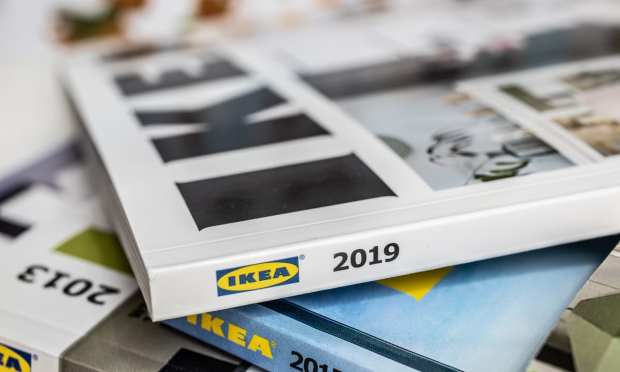Ikea And What Comes Next For Printed Catalogs

It’s been a seven-decade-long run, but Ikea is formally saying goodbye to its printed catalog.
The decision was announced Monday (Dec. 7) as the Ikea brand continues to shift itself to digital, according to published reports. Catalog readership has resultantly declined precipitously over the past several years.
Published reports indicate that in the past year, Ikea has seen online sales increase by 45 percent. The number of visits to Ikea.com has likewise exploded to 4 billion in the last year alone, driven in no small part of the COVID-19 pandemic and consumer reluctance to transact in physical spaces.
In the past eight months alone, Ikea has upgraded its suite of apps to make it easier for consumers to complete furniture purchases digitally. The chain has also redesigned its physical stores’ footprint in some areas to be small and friendly to urban location placement.
The World’s One-Time Hottest Read
At a peak four years ago, Ikea distributed 200 million catalogs worldwide in 32 languages. The BBC once reported that the Ikea catalog was the world’s largest publication, with more copies printed than either the Bible or the Quran.
“For 70 years, [the catalog] has been one of our most unique and iconic products, which has inspired billions of people across the world,” said Konrad Grüss, managing director, Inter IKEA Systems BV. “[But] media consumption and customer behaviors have changed, and Ikea is already increasing digital investments while volumes and interest in the catalogue have decreased.”
But although the catalog is signing off, Ikea announced that it won’t be forgotten. The chain plans to commemorate it with a book due out next autumn.
Not Everyone Is Giving Up on Catalogs
Of course, it’s not surprising that a retailer looking to focus on digital is exiting print. The same trend has been underway for the past decade or so in mass-market publishing. Print runs of books, newspapers and magazines have been more or less continuously on the decline as consumer preference for digitized content grows in the mobile era.
What’s perhaps eye-catching in Ikea’s case and for the world of catalog publishing in general is how inconsistent that pullback actually seems to be when one looks at retail. For every Ikea that pulls out of the printed-catalog business, there seems to be a digital brand that’s pushing forward with a new physical catalog all its own.
The hot catalog trend of the past two years, at this time of year in particularly, has been around toy sales. This year, Amazon released its second-annual toy catalog, joining printed catalogs from both Walmart and Target.
Like the catalogs of years past, these books are chock full of attractively photographed gift ideas for children — Lego sets, Barbie’s various dream houses, art kits, Star Wars toys, etc.
But what sets the new catalogs apart from their predecessors of yesteryear is how customers actually order gifts. Instead of having to search about for a postcard to fill out to mail in one’s order list, every item comes with a description and QR code printed alongside it. That makes it easy for shoppers to scan and be taken directly to the retailer’s page (or mobile app) when they’re ready to make a purchase.
Catalogs Can Have Their Value
Hanging on to catalogs as a sales strategy isn’t just nostalgia for shopping seasons past, according to Tim Curtis, president of direct mail consultancy CohereOne. It’s actually a strategy with a pretty solid backing in what we know about the human mind.
“We know from neuroscience that this medium [direct mail] is extremely effective at building an emotional connection with customers and driving demand,” he said.
And that deeper emotional connection is actually measurable with data. The response rate to direct mail pieces is 3.7 percent, according to reporting in Forbes. That beats 2 percent for mobile, 1 percent for email, 1 percent for social media and 0.2 percent for internet display ads.
Creating physical collateral is more expensive than creating digital collateral, of course, but Forbes data indicates that that cost pays for itself. Leveraging the direct mail channel, U.S. advertisers spend $167 per person on direct mail to earn $2,095 worth of goods sold — an ROI of 1,300 percent.
Moreover, catalogs also tend to have a bit more staying power when it comes to holding on to consumer attention, according to reports. On average, consumers spend 15.5 minutes looking at a catalog and keep it on their coffee tables for several weeks. Some 72 percent of consumers say catalogs make them more interested in a retailer’s products, and 84 percent report making a purchase after seeing an item in a catalog.
Do catalogs work for every brand? Apparently not, since Ikea is pulling the plug on its catalog after nearly 70 years for lack of efficacy in recruiting customers or driving sales.
But are catalogs going to disappear? Almost certainly not, because as holiday 2020 makes clear, when used in the right contexts, they can still pack a lot of revenue-generating punch.
